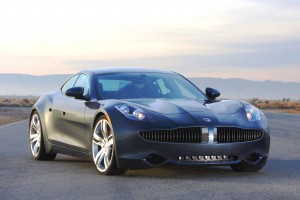The Fisker saga continues today when a judge will decide if the assets of the now-defunct electric-vehicle maker can be purchased by one company or if they’ll be opened to an auction.
Hybrid Technologies, a company owned by Richard Li, a Hong Kong billionaire, is seeking to secure the assets, including the former General Motors plant in Delaware where Fisker planned to build a second model, for $75 million, according to court documents.
However, there is a second plan being pulled together by Wanxiang Group Corp., which wants to assets put out for bid.
Fisker, founded by designer Henrik Fisker, secured a loan $529 million from the U.S. Department of Energy (DOE) to produce the vehicle. It drew $168 million from the loan before access to the funds was cut off by the government.
Hybrid purchased the loan for just $25 million, and is now attempting to buy all of the assets in a $75 million credit-based bid. Hybrid is Fisker’s senior secured lender since it bought the loan from the DOE as well as its debtor-in-possession lender.
Hybrid’s U.S. plans for Fisker are unclear, but it has indicated it will likely sell the Delaware plant. It also asked the bankruptcy court to place a “zero-dollar estimate” on a $3.8-million claim by the company’s nearly 150 former employees who were not paid when the company shut down.
U.S. Bankruptcy Judge Kevin Gross criticized Hybrid for the move and ordered an evidentiary hearing for Jan. 31.
“The debtors’ bankruptcy is a tragedy for many while the purchaser tries to purchase the Fisker assets using discount dollars,” the judge wrote in a recent order. “United States taxpayers, Delaware taxpayers, employees, unsecured creditors are all losers. The emergence of another very interested, cash-paying suitor, Wanxiang America Corporation, may enhance creditor recoveries and shows the mischief from undue speed.”
Wanxiang wants to resume production of the Fisker’s Karma in Finland and eventually shift production to a Michigan-based facility, according to court documents.
The Chinese company also said if demand was sufficient, it would use the Delaware plant to produce a second model. This would be music to the ears of Delaware officials. The state’s economic development authority provided Fisker with nearly $20 million in loans and tax breaks to lure the company to there to manufacture Fisker’s never-produced second vehicle, the Atlantic, at the former GM site.
Wanxiang has the support of second-tier creditors who will see nothing under the Hybrid plan for reorganization. Wanxiang also asked U.S. Bankruptcy Judge Kevin Gross to force Hybrid to put more cash into its deal, by capping the credit portion of its offer at $25 million instead of the aforementioned $75 million. Hybrid is currently offering just $2 million in cash while Wanxiang is offering $35.7 million in cash and wants to be named the lender for Fisker’s debtor-in-possession financing.
(U.S. sets new record for fuel economy in 2013. For more, Click Here.)
As recently as 2011, Fisker Automotive seemed one of the most promising of a new flock of contenders who hoped to challenge the established automotive order with an assortment of “green” machines. Many of these were seriously underfunded or chose to focus on quirky designs with questionable appeal to more than micro-niches in the U.S. market.
(Click Here to see Fisker’s tumble into restructuring.)
The maker also rolled out a sexy design for the Karma penned by Fisker, perhaps best known for his prior work at Aston Martin. The plug-in was promised to deliver not just great fuel economy and reasonable battery range – much like the pedestrian Chevrolet Volt plug-in – but the high-performance of a sports car.
Unfortunately, Karma fell short in most of those categories, receiving lower mileage ratings than expected from the EPA, and getting mixed to negative reviews from the automotive media. Its design still inspired many buyers but even then, things began to go wrong when the company missed some key development and production milestones.

